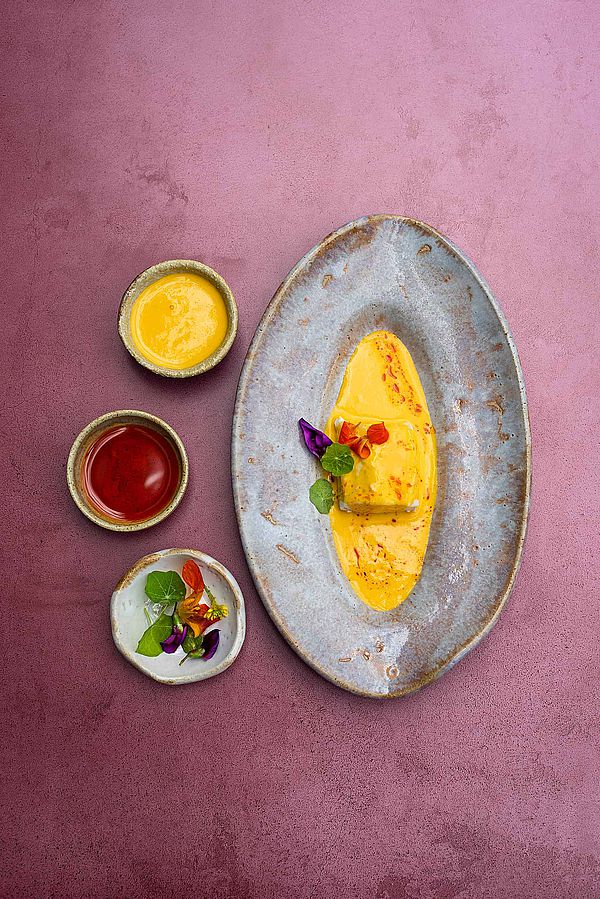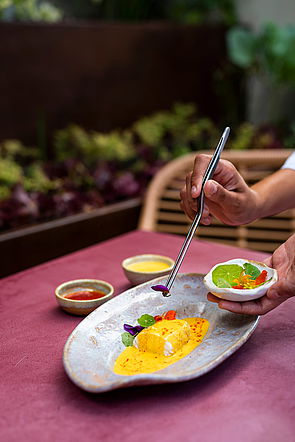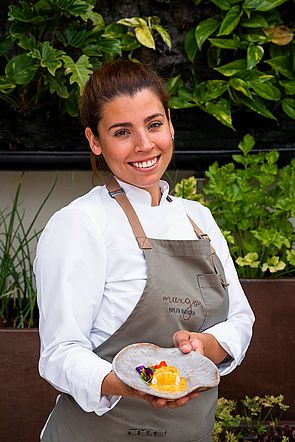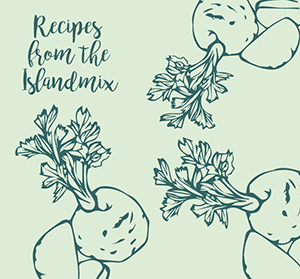240 gr. sea bass (60 g. per person)
175 ml. carrot puree (approx. 10 servings)
2 garlic cloves
3 carrots for the stir-fry
5 onions, sliced into julienne strips
250 ml sherry vinegar
0.5 l olive oil 0.4
175 ml vegetable stock
100 gr. sweet paprika
Black pepper (a sufficient amount)
Thyme (a sufficient amount)
Salt
Preliminary Step
Place the sea bass portions in the oven and steam for 6-7 min. at 90º.
Place to one side.
Marinade
Stir fry the carrots with the olive oil, onions and garlic cloves. Once everything is thoroughly cooked through, add the sherry vinegar, black pepper, thyme and salt. Add the vegetable stock. Mix together and leave it to strain off all the juice. Then set aside.
Blend the 10 carrots. When assembling the dish, gradually add the liquefied paste to the juice obtained previously, to obtain the carrot pickle.
Paprika Oil
To make the paprika oil, put 300 ml of olive oil 0.4 in a saucepan with 100 grams of sweet paprika, salt and leave to cook over a low heat without boiling, otherwise the paprika would become bitter. Set aside and strain into a clean recipient or ‘superbag’ to keep the oil clean.

When it is ready to serve, place a portion of sea bass in the centre of each plate, cover it with the carrot marinade and finally add the paprika oil. Decorate with edible flowers.


“For the preparation of this dish, KM 0 or locally sourced products have been used, such as Aquanaria Atlantic sea bass and carrots from farmers’ markets. At our restaurant we place a great importance on this type of products and we work with them all the time” explains Carla Betancor.
“Sea bass, farmed in the waters off the coast of Gran Canaria, is a product of the highest culinary quality. It is of good size, has intense flavour and firm texture, as its fat is well distributed and infiltrated throughout its musculature. This fish is sent fresh to any part of the world and is used to the full, from the loin, belly, tail and chin to the head, gonads, skin and fat”, adds the chef.

‘Dish-enhancing’ secret ingredient
Valsequillo carrots
Grown on both conventional and organic farms, are the undisputed star of all vegetable gardens. A perfect accompaniment in stews and broths, their flavour and texture are the perfect complement to almost any dish.
The municipality of Valsequillo is an eminently agricultural territory, whose primary sector generates a large number of the top products grown in Gran Canaria. Fine samples of its produce can always be found on the island's food markets and agricultural markets.